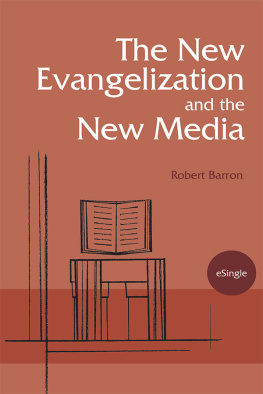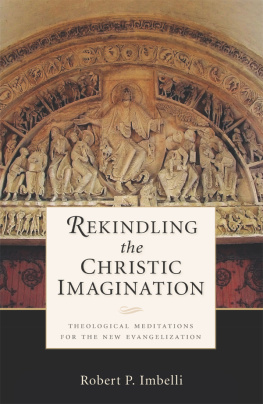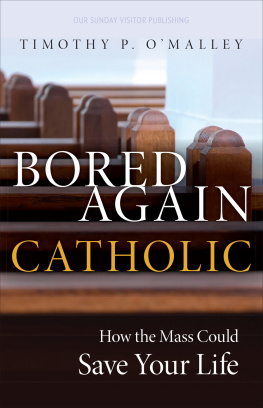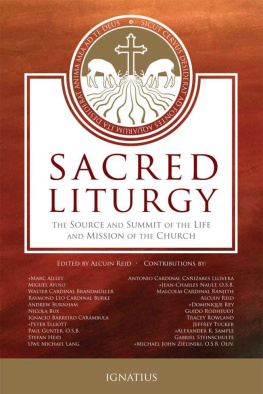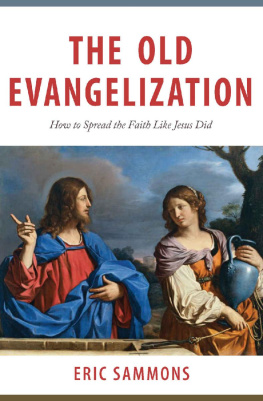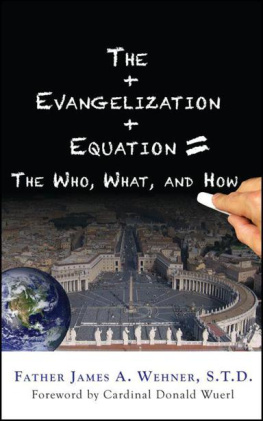Unless otherwise noted, scripture texts in this work are taken from the New Revised Standard Version Bible: Catholic Edition 1989, 1993, Division of Christian Education of the National Council of the Churches of Christ in the United States of America. Used by permission. All rights reserved.
Other scripture texts reprinted from the Tanakh: The Holy Scriptures by permission of the University of Nebraska Press. Copyright 1985 The Jewish Publication Society, Philadelphia.
Excerpts from the English translation of the Catechism of the Catholic Church for use in the United States of America copyright 1994, United States Catholic Conference, Inc.Libreria Editrice Vaticana. English translation of the Catechism of the Catholic Church: Modifications from the Editio Typica copyright 1997, United States Catholic Conference, Inc.Libreria Editrice Vaticana. Used with Permission.
Excerpts from the General Directory for Catechesis 1971 Libreria Editrice Vaticana (LEV); excerpts from Evangelium Nuntiandi 1975 LEV; excerpts from Catechesi Tradendae 1979 LEV; excerpts from the Lineamenta of the XIII Ordinary General Assembly of the Synod of Bishops 2011 LEV. Used with permission. All rights reserved.
Excerpts from the English translation of The Roman Missal 2010, International Commission on English in the Liturgy Corporation. All rights reserved.
Excerpts from documents of the Second Vatican Council are from Vatican Council II: Volume 1, The Conciliar and Post Conciliar Documents, by Austin Flannery, OP 1996 (Costello Publishing Company, Inc.). Used with permission.
Portion of Revelation by Flannery OConnor 1956, 1957, 1958, 1960, 1961, 1962, Flannery OConnor. Copyright renewed 1993 by Regina Cline OConnor. Reprinted by permission of the Mary Flannery OConnor Charitable Trust via Harold Matson Company, Inc.
Excerpts from Discernment and Truth: The Spirituality and Theology of Knowledge by Mark A. McIntosh (2004) by permission of Crossroad Publishing. All rights reserved.
Excerpts from Souls in Transition: The Religious and Spiritual Lives of Emerging Adults by Smith and Snell (2009) by permission of Oxford University Press, USA.
Portions of chapter 3 reprinted from The Kerygmatic Function of Liturgical Prayer: Liturgical Reform, Meaning, and Identity Formation in the Work of Josef Jungmann, S.J., Studia Liturgica, Volume 41, Number 1, 2011, pages 6871. Used with permission. All rights reserved.
2014 by Order of Saint Benedict, Collegeville, Minnesota. All rights reserved. No part of this book may be reproduced in any form, by print, microfilm, microfiche, mechanical recording, photocopying, translation, or by any other means, known or yet unknown, for any purpose except brief quotations in reviews, without the previous written permission of Liturgical Press, Saint Johns Abbey, PO Box 7500, Collegeville, Minnesota 56321-7500. Printed in the United States of America.
The Library of Congress has cataloged the printed edition as follows:
Library of Congress Cataloging-in-Publication Data
OMalley, Timothy P.
Liturgy and the new evangelization : practicing the art of self-giving love / Timothy P. OMalley.
pages cm
Includes bibliographical references.
ISBN 978-0-8146-3764-7 ISBN 978-0-8146-3789-0 (ebook)
1. EvangelicalismCatholic Church. 2. Catholic ChurchLiturgy.
3. Liturgical adaptationCatholic Church. I. Title.
BX1397.O43 2014
264'.02dc23
2013037432
In gratitude to my wife,
Kara,
who has taught me to live the nuptial liturgy
each day of our married life.
Contents

The gift of real love is something that each human being desires. We first know this love while gazing into the eyes of our parents. We seek authentic friendships, ones in which a communion of souls takes place. We desire romantic love, to encounter another human being whose beauty and goodness is transformative of our identity. We are made to love, to give ourselves away as a response to the gift we have already received.
Whatever the new evangelization is, it is incomprehensible outside the domain of love. Not simply the love of one human being for another, though such love is indeed very good. Rather, the churchs mission of the new evangelization is coming to perceive anew the logic of self-giving love revealed in Jesus Christ; a revelation of divine love that expands our imaginations regarding the possibility of what human love could become when knit into the triune Gods own life. The new evangelization, for this reason, is nothing less than a recommitment to Gods own pedagogy of love as mediated through the churchs ministries of proclamation, prayer, and mission.
Because the new evangelization is fundamentally a renewal of the churchs eyes of love, it must be liturgical. Of course, this claim can easily be misunderstood. The liturgical context of the new evangelization is not simply an affirmation of the centrality of liturgy in the churchs life. Instead, what I mean to propose is that the practices of the churchs liturgical rites function in such a way that they are to inform every aspect of the churchs mission of the new evangelization. For in liturgical rites, we do not only consider the love of God as a theoretical possibility but we participate in such love through visible signs and words. Our desires and hopes, our sorrows and tears, are taken up into Gods own life and made into a spiritual offering. In such moments, we allow Gods own gift of love to be written upon the contours of our bodies, now given over to the world as a sacramental offering: present your bodies as a living sacrifice, holy and acceptable to God, which is your spiritual worship. Do not be conformed to this world, but be transformed by the renewal of your minds, so that you may discern what is the will of Godwhat is good and acceptable and perfect (Rom 12:1-2). As long as the purpose of the new evangelization is humanitys partaking in the self-giving love of God, then liturgical prayer is integral to this new evangelization.
This book ultimately has three purposes relative to articulating the liturgical task of the new evangelization. First, it seeks to develop a liturgical and thus theological argument about the nature of the new evangelization. The new evangelization is not simply about the adoption of novel pastoral programs, the cultivation of small-group faith sharing, the strengthening of Catholic identity in schools and parishes, the use of social media in spreading the Gospel, or a renewed confidence in performing public professions of faith. These are instruments that are part of a larger narrative, one that has yet to be fully articulated. As the Lineamenta for the Synod on the New Evangelization states:
Presently, in reviewing the dynamics of the new evangelization, the expression can now be applied to the Churchs renewed efforts to meet the challenges which todays society and cultures, in view of the significant changes taking place, are posing to the Christian faith, its proclamation and its witness. In facing these challenges, the Church does not give up or retreat into herself; instead, she undertakes a project to revitalize herself. She makes the Person of Jesus Christ and a personal encounter with him central to her thinking, knowing that he will give his Spirit and provide the force to announce and proclaim the Gospel in new ways which can speak to todays cultures.



